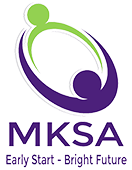Answers to 5 Common Speech and Language Concerns in Children
August 8, 2016
One of the most common concerns among parents and caregivers of young children is speech and language development. This post’s contributing author is Betty Aboff, an MKSA Speech-Language Pathologist with 25 years’ experience in evaluating and providing therapy for children.
Is your child developing speech and language skills like other children? Is your child at age level? Children develop these skills at different ages, and there is a wide range of normal development. Let’s learn more about children’s speech milestones and when one should be concerned.
1. Why can’t my 2-1/2-year-old child say “s” and “th” sounds?
A child at age 2½ is only expected to be approximately 65-70% intelligible when speaking. We are not concerned with difficulties in articulation (the production of certain sounds) until a child is at least 3 years old unless it’s severe. Even at age 3, it depends upon which sounds the child is having difficulty with. At age 3, a child should be able to say sounds produced using his lips, including “b,” “p,” “m,” and the tongue, including “t,” “d,” and “n.” At age 4, a child should say the “r” sound and “back sounds” such as “k,” and “g”. At age 4 ½, the “s,” “sh,” and “ch” sounds should be produced. At age 6-7 a child should say “later sounds” including: “v,” “th,” “j,” “z” and blends (2 consonants together).
2. Why does my 3-1/2-year-old child stutter a lot?
Stuttering among children ages 2½-5, when they are still learning how to speak, is very common and is not a cause for concern. This is called “developmental dysfluency,” which appears in about 25% of all children at that stage and will usually disappear if left alone over time. As therapists we don’t address it and we discourage parents from telling their child to “slow down” or “think about what you want to say.” We don’t want to call attention to the dysfluencies. Never finish a child’s sentences for him. Act as if you have plenty of time to hear what your child has to say. Model slower speech for your child. When at home, insert extra pauses, simplify your own language and maintain normal eye contact with your child. Reassure your child that talking can sometimes be hard for everyone. If your child develops what are called “secondary characteristics” such as eye-blinking, foot stamping or facial grimaces, or if the stuttering gets worse, the dysfluencies should be addressed by a speech therapist.
3. Why does my 2-year-old child only say a few words?
Normal speech and language development in children can proceed at very different rates. It is common for many 2-year-olds to have a 40-50 word vocabulary and to be just starting to put 2 words together. Other children develop language skills faster, and can manage to conduct a conversation at that age. However, if a 2-year-old child only has a few words, isn’t imitating words, and is having trouble understanding language and commands addressed to him I would suggest having the child’s hearing tested, and a speech and language evaluation is recommended.
4. Why must my 4-year-old child be told something multiple times before he follows directions? He also has trouble with answering questions and repeats what you ask rather than giving you a response.
If he has not been already, your child should be tested for auditory processing (the ability to understand spoken language) difficulties as part of a complete audiological evaluation, to discover if the source of the difficulty is behavioral, processing or a combination of both. In the meantime, before giving your child directions, make sure you have gained his complete attention. Speak slowly and clearly, but don’t over-exaggerate your speech. Your directions should be simple and brief. Try to use visual aids such as pictures or actual objects and written instructions to supplement your spoken words. While speaking to your child, emphasize key words, and ask him to repeat your instructions back to you to make sure that he understood what you told him. Next year in Kindergarten he will be expected to follow directions and answer questions. If he has auditory processing difficulties, it will become more apparent in the classroom setting. This is the time to work try to give him compensatory strategies in order to function better in the classroom setting.
5. I have three children under the age of 5. Can you give me tips for helping them develop their language skills?
Below are some recommended techniques:
Expansion: Expand what your child says. If your child says “mommy,” you say, “Where is mommy’s car?”
Modeling: Provide a good model for the child to follow. If your child says, “baby hurt,” you say, “put a band-aid on it.”
Parallel talk: Comment on the actions of yourself or your child, with the hope that your child will begin to do the same.
Imitation: Have your child imitate your words after you, to hopefully begin to use them spontaneously.
Association: When a child comes across a new experience or word, supply additional vocabulary words. If your child says “car,” you say, “It is a car and it has wheels like daddy’s car.”
Repetition: Repeat the same new words over again in front of your child in many different contexts; eventually your child will begin to use the words himself.
Try these techniques at home and keep praising your child each time he tries to use a new word. Encourage him to want to learn new words and use them.
As with any concerns, speak with your child’s pediatrician first. MKSA is always available to answer questions and make appropriate referrals. For more information about MKSA’s services including speech-language therapy, click here.
